Completing Nurse Tree Planting
Phil Dunn from Ribbonwood Nurseries had already given Glen Riley from Habitat Restorations and myself the news that there would not be enough trees to complete Area 3 before planting started on 28 August 2024. We had a cold May and some of the trees needed more growing time at the nursery.
Although it was disappointing, I knew that it was better to wait for a couple months than to plant trees that may not make it through a sudden cold snap. It meant too that Habitat Restorations had to make two visits to the property, with the additional time to start up and shut down being an additional cost to me.
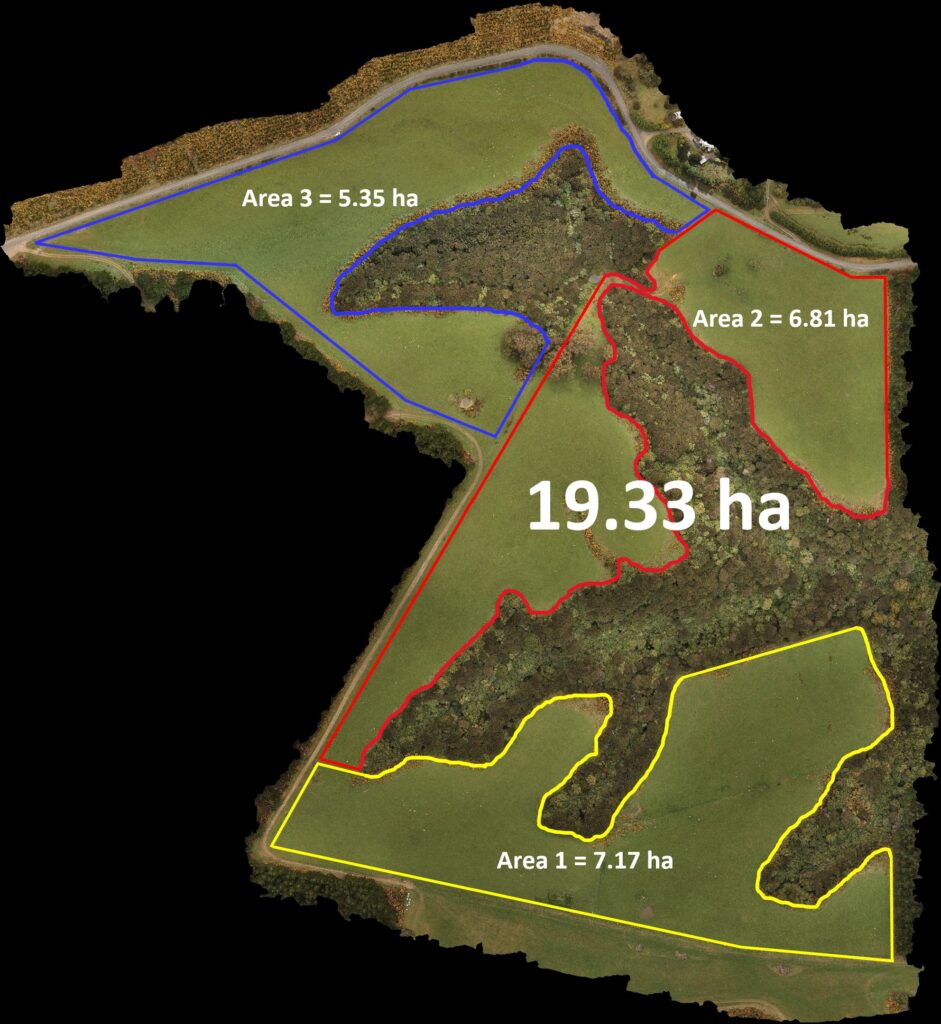
Gorse Removal
Prior to the arrival of the planting crew, I used the time to continue my campaign to cut the gorse that grew along the interface line between the pasture and the existing forest. Area 3 had the thickest gorse, and on some days I only moved 5 or 6 metres along that interface line. My typical day was 15 metres of progress. It was difficult and slow. There were no gaps in the gorse, some of which were nearly 20 metres deep. The gorse bushes were up to 7 metres tall (or long, because they did not all grow up).
Cutting the gorse in Area 3, alongside Taieri Beach Road, exposed a glade of Tree Fuchsias (Kotukutuku), which now have better access to the sunshine. It’s one of only 11 deciduous trees in New Zealand, and is the world’s largest fuchsia, growing up to 15 metres tall. Its distinctive orange, papery bark adds colour under the tree canopy. In the springtime, I will now have a streak of scarlet flowers visible from the road. Nectar from the flowers is sought after by Tui and Bellbirds, which already exist in the forest.
I finished cutting the gorse just prior to the arrival of the planting crew for the final round of planting in October 2024. I estimate that I cut 15,000 square metres of gorse.
I didn’t paint the stumps because there was enough to do, crawling under the bushes and carting the cut stems down into the forest, without also having to manage a container of poison and applicator. My plan is to return and spray the regrowth for the next few years, until the trees start crowding out the gorse.
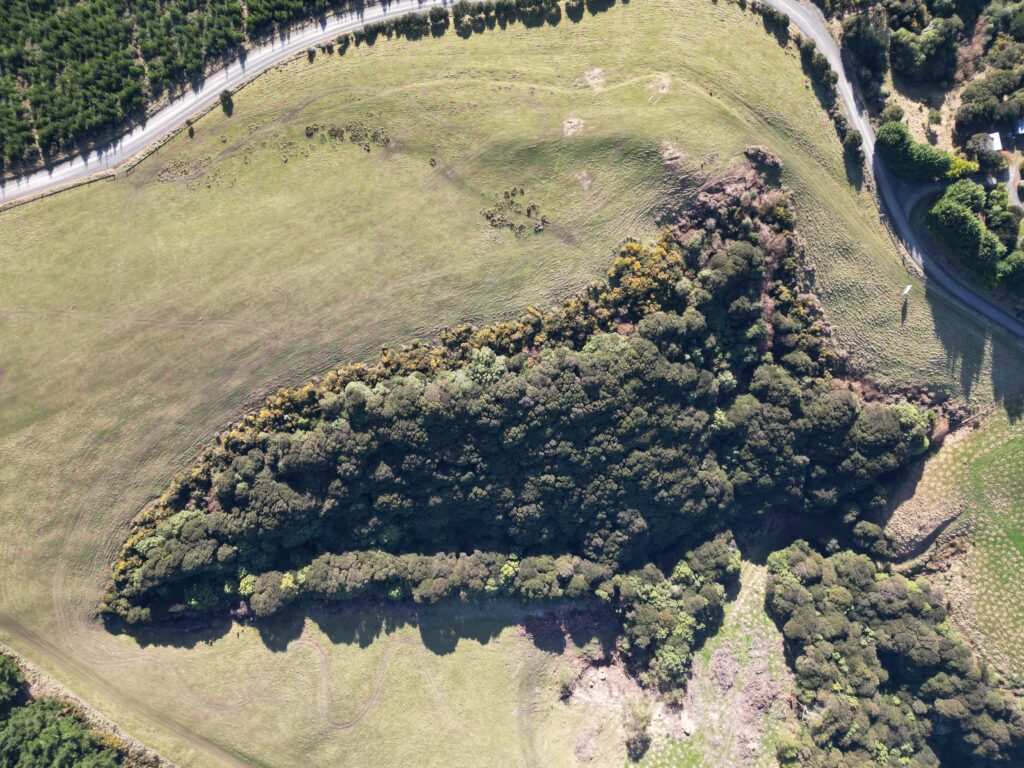
Subdivision Survey
The planting crew arrived on 27 August 2024 and started planting near the road, working up the hill to the Kauri Trees sign.
The land surveyor, Haydon McLeary from Terramark was out the day before, and we pegged out the subdivisions and the unformed Akatore Creek Road duplication, which I hope to stop, and purchase from Clutha District Council. The road duplication is wholly in pasture, and I planted it in trees, and I don’t want a member of the public claiming access to road because it remains on Council maps.
Pegging out the driveway and house lot was useful because it established the boundary of the 4,000 m2 required by Council, that shouldn’t be planted. Excluding it from planting is not just because of the house, but also a buffer zone for the construction machinery that will be used to build it.
That was one area excluding from planting. The other excluded area was a flat section of ground right on the south-west boundary point, where Akatore Creek Road turns the corner to head south along the boundary line. I’m going to use this area to dump the 500 m2 of soil that will be removed from the building site for my house. It will likely create a mound that is 2 m high, so the excavator will need to sculpt it into a natural-looking feature.
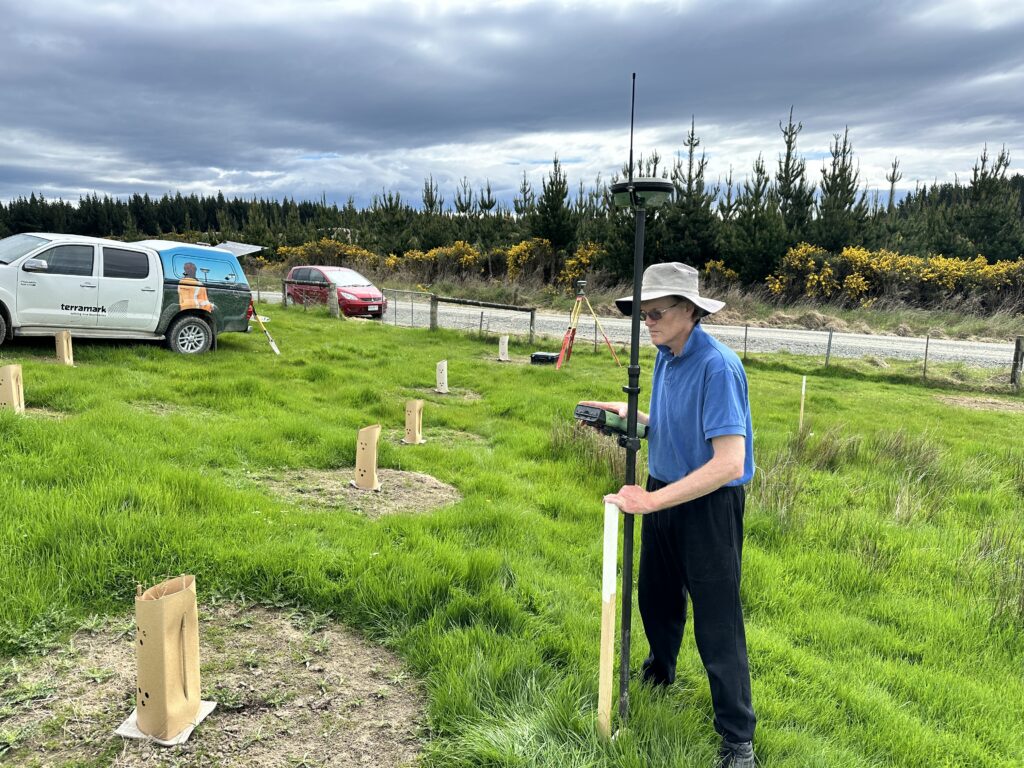
Planting progress was consistent with the other Areas – between 500-600 trees per day. It was great to welcome back familiar faces: Glen Riley of course, but also Amber Pringle, Angus Norton and Will Mister.
They all know what to do and just get on with the job. The planting experience was similar to Areas 1 and 2, and despite the slopes rising up to the flatter section in the middle of Area 3, planting was easier. Maybe it felt easier because of the terrain, or the better weather, or the experience I already had.
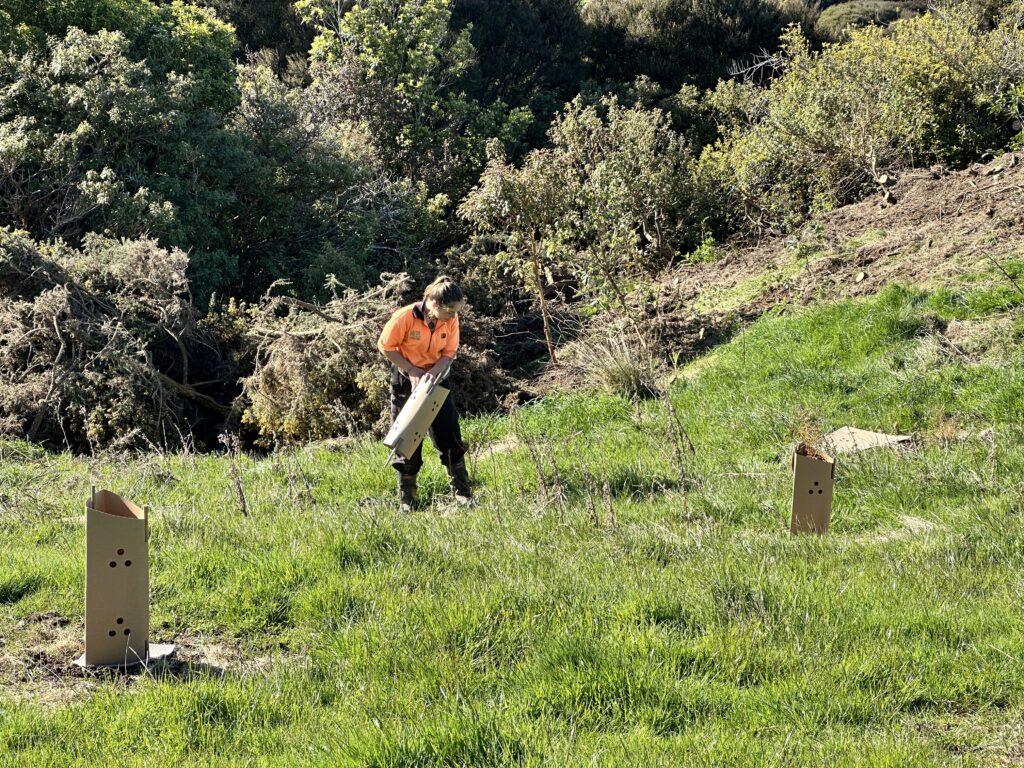
Wild Sheep
Before the Habitat Restorations crew arrived, I was walking along the southern boundary fence and saw two sheep in Area 1. There was a lot of grass in the paddock, so they were grazing on it, not the trees. As I was walking along the boundary road towards the sheep. My plan was to open the gate into Martin Denton’s place, circle down the hill, and guide them through the gateway. But as soon as they saw me, they charged into the gully forest. With the long grass, it was always going to be an impossible chase.
I told the planting crew about my experience, and in the afternoon, they spotted the sheep grazing. Angus has a shooting licence, so he brought his rifle. The following day they appeared again. Angus headed off down the hill, crossing the primary gully to get to the paddocks in Area 1. From our vantage point at the top of the hill in Area 3, we could easily see his day-glow jacket (talk about camouflage!).
Angus Norton stalked the prey, then fired 3 rounds. Both sheep were killed. Will headed off on the side-by-side to transport the carcasses back.
When they returned, both carcasses had already been gutted, so only skinning and butchering were required. It made them easier to transport to Dunedin in the back of the trucks. There’s one thing though: we questioned Angus why he needed 3 shots to hit 2 animals. He explained that his gun sights were set high (for a longer range), so he had to quickly make adjustments to hit the targets. We joked with him that it seems setting the range was part of Shooting 101!
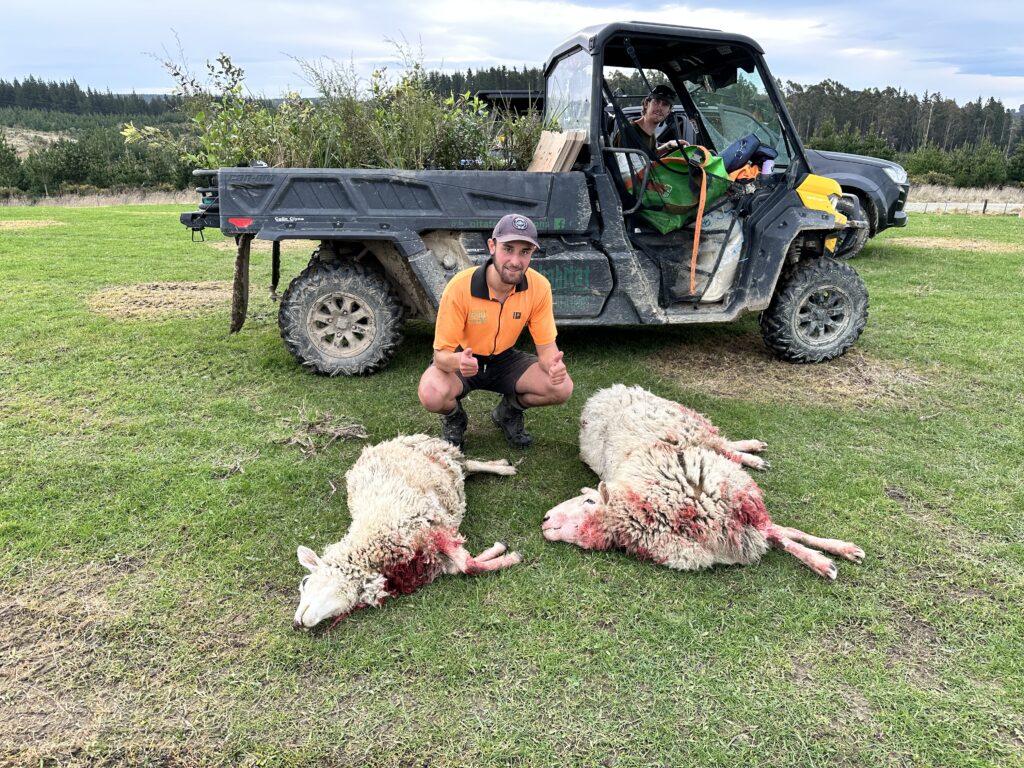
End of Round One
As with Area 2, Phil Dunn supplied some new varieties. There have been adjustments over the planting campaign to create greater species diversity. It may be a result of what happens to be available at the time, but more is better, right? (especially if natural propagation can occur in subsequent seasons). In the end, I had 44 different varieties in the ground. Some important species were introduced for the first time: Kahikatea (NZ’s tallest tree), Mountain beech, Mikimiki, Mahoe and Toi toi. Glen Riley also supplied some red tussock, to add some colour around where the house will be. He’s always thinking about which plant to place where – a most engaged man.
After just 4 days of planting, we exhausted the trees available in August. Glen spaced out the last of the trees so we didn’t end up with a mono-culture. We returned in mid-October 2024 and completed 2 days of planting, bring Area 3’s tree count up to 3,490.
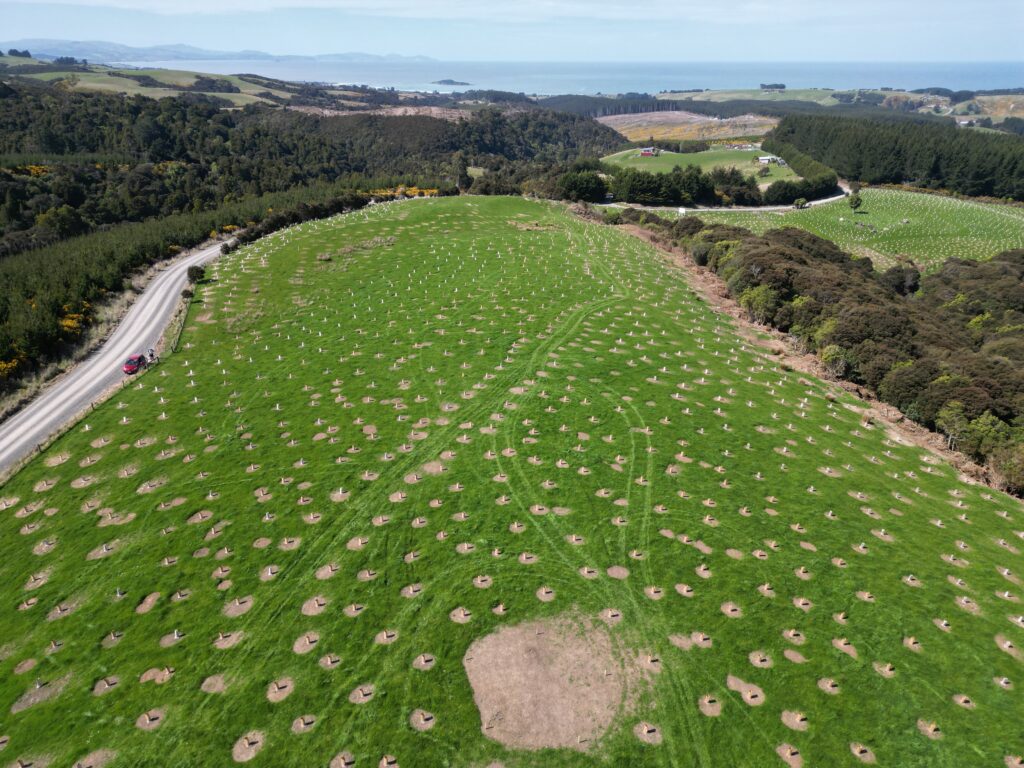
Over the whole campaign, 17,041 plants have transformed the pasture into a nascent forest, at a density of 882 plants/ha.
It was extremely satisfying to complete this first round in just 15 months. My sincere thanks go to Glen Riley and his committed team from Habitat Restorations Aotearoa, and to Phil Dunn and his equally committed team at Ribbonwood Nurseries.
Without these two individuals and the organisations they lead, I could never have completed the preparation work required for the Kauri forest.
My feeling is that the Kauri trees should be easier. The only selection process is to ensure the provenance of the trees (from the three separate seed sources) is maintained so future researchers will be able to different the trees groups and perhaps reach some conclusions of the effectiveness of seeds sourced from different North Island locations.

The video of the Area 2 and 3 planting is KT024, which can be viewed here or on the Kauri Trees YouTube channel.
28 November 2024
